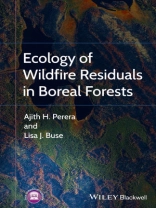Large and intense wildfires are integral to the globally important boreal forest biome. While much is known about boreal wildfires, the focus on forest remnants that either escape or survive these intense fires is a recent phenomenon: academics now study ecological processes of wildfire residuals, forest policymakers use their patterns to design harvest strategies, forest managers consider their economic value, and conservationists recognize their intrinsic ecological importance.
Ecology of Wildfire Residuals in Boreal Forests is the first book to explore ecological patterns and processes of what does not burn within boreal wildfires. Following a brief introduction to the boreal forest biome, it discusses the processes that form wildfire residuals; how they are studied, with various approaches and methods; the types, extent, and ecological functions of wildfire residuals; and their role in forest management applications, all in the context of ecological scale.
This book is a reference for researchers and graduate students studying boreal forest ecology, as well as for policymakers and forest managers. It adopts a non-reductionist perspective that will be of interest to scientists from conservation science, forest ecology, forest management, and timber production.
- Brings together fire behaviour, ecological scale, vegetation ecology, and conservation biology to provide a cross disciplinary, multi-scale, and an integrative discussion of forest fire residuals
- Captures the state of knowledge with a meta-analysis of research trends during the past few decades, with a comprehensive review of the literature, a compilation of key references, and a list of key topics relevant to the study of boreal wildfire residuals
- Identifies the major gaps and uncertainties in the present body of knowledge, including a critique of study techniques and reporting practices to date, and proposes a set of terms and definitions and a list of research questions and priorities
- Includes the authors’ observations and research experience from boreal Canada, and information extracted from interactions with North American and European ecologists, forest managers, and conservationists
Mục lục
Acknowledgments xi
About the companion website xiii
1 Introduction 1
The boreal forest biome 2
Geographical distribution 4
Distinguishing features 6
Boreal wildfires 9
Major characteristics 9
Ecological significance 11
Goals and scope of the book 12
References 14
2 Formation of wildfire residuals 18
Factors that affect the formation of residuals 19
Boreal forest communities 20
Boreal wildfires 31
Residual formation and distribution 40
Spatial heterogeneity in fire behavior 41
Process of residual formation 44
Summary 59
References 61
3 Types of wildfire residuals and their extent 65
Types of wildfire residuals 66
A post-wildfire scene 66
Past descriptions of wildfire residuals 71
Abundance and extent of wildfire residuals 79
Snag residuals 80
Live tree residuals 81
Residual patches 84
Changes in residuals after wildfires 88
Snag residuals 88
Live tree residuals 89
Residual patches 92
Toward improved definitions and assessment 93
Reasons for improvement 93
Definitions of wildfire residuals 95
Improved study approaches 103
Summary 107
References 113
4 Ecological roles of wildfire residuals 119
Ecological processes involving snag residuals 121
Invasion by beetles 121
Colonization by woodpeckers 132
Occupation by other bird species 140
Forest regeneration 142
Roles of the residual patches 148
Providing temporary shelter 149
Supplementing the recovery 151
Creating heterogeneity 161
Ecological significance 161
Wildfire residuals and the carbon cycle 162
Wildfire residuals and nutrient and hydrological cycles 165
Summary 168
References 173
5 Role of wildfire residuals in forest management applications 184
Restoring wildfire residuals 185
Ecological expectations 186
Considerations for application 187
Challenges and uncertainties 190
Emulating wildfire disturbance 191
Background 191
Emulating wildfire residuals by forest harvest 193
Expectations and uncertainties 197
Salvage logging 202
Background 202
Ecological consequences 204
Practical considerations 212
Uncertainties 217
Summary 220
References 222
6 Ecology of boreal wildfire residuals – a summary and synthesis 227
Wildfire residuals and their occurrence 227
Residual vegetation types 228
Spatial patterns of residuals 231
Ecological roles of wildfire residuals 235
Snag residuals 235
Residual patches 236
A conceptual view 237
Knowledge uncertainties 239
Management applications and wildfire residuals 240
Salvage logging 240
Emulating wildfire disturbances 240
Restoring wildfire residuals 242
Suppressing fire 243
Research needs on wildfire residuals 243
Advancing research methods 243
Expanding research topics 244
Conclusion 245
Index 247
Giới thiệu về tác giả
Ajith H. Perera is a senior research scientist and leads the Forest Landscape Ecology Program at the Ontario Forest Research Institute in Ontario, Canada. He has over twenty-five years of research experience in landscape ecology, much of it focused on understanding patterns and processes of boreal forest fire regimes. He has
authored many scientific publications, including several books.
Lisa J. Buse is a forest biologist who specializes in knowledge transfer at the Ontario Forest Research Institute. She has over twenty years of experience in communicating forestry sciences to practitioners, especially on forest landscape ecology including wildfire disturbances in boreal Ontario. She has also published many scientific publications and co-edited three books.












